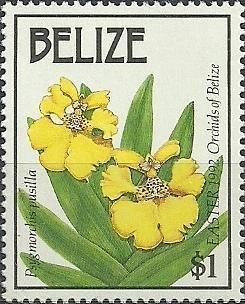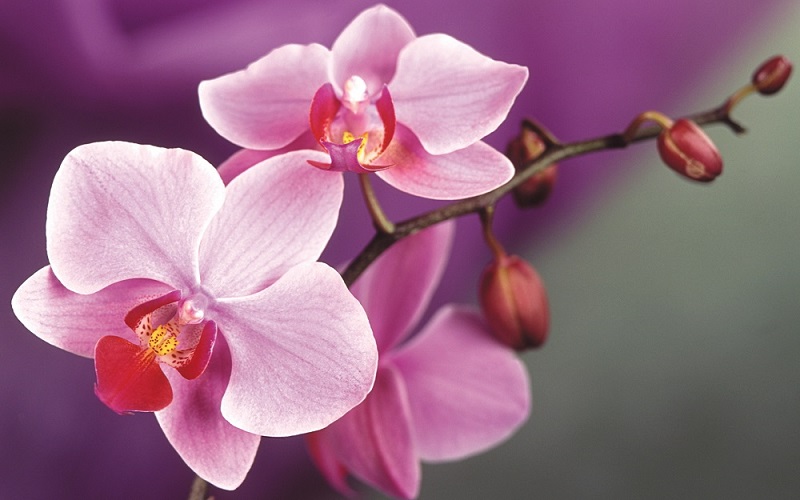Stamp: Erycina pusilla (syn.Psygmorchis pusilla (Belize 1992)
Erycina pusilla (syn.Psygmorchis pusilla (Belize 1992)
01 April (Belize ) within release Easter - Orchids goes into circulation Stamp Erycina pusilla (syn.Psygmorchis pusilla face value 1 Belize dollar
| Stamp Erycina pusilla (syn.Psygmorchis pusilla in catalogues | |
|---|---|
| Michel: | Mi:BZ 1088 |
| Stamp Number: | Sn:BZ 989 |
| Stanley Gibbons: | Sg:BZ 1124 |
Stamp is vertical format.
Also in the issue Easter - Orchids:
- Stamp - Gongora quinquenervis face value 25;
- Stamp - Oncidium sphacelatum face value 50;
- Stamp - Encyclia bractescens face value 60;
- Stamp - Epidendrum ciliare face value 75;
- Stamp - Erycina pusilla (syn.Psygmorchis pusilla face value 1;
- Stamp - Galeandra batemanii face value 2;
Stamp Erycina pusilla (syn.Psygmorchis pusilla it reflects the thematic directions:
A flower, sometimes known as a bloom or blossom, is the reproductive structure found in plants that are floral (plants of the division Magnoliophyta, also called angiosperms). The biological function of a flower is to effect reproduction, usually by providing a mechanism for the union of sperm with eggs. Flowers may facilitate outcrossing (fusion of sperm and eggs from different individuals in a population) or allow selfing (fusion of sperm and egg from the same flower). Some flowers produce diaspores without fertilization (parthenocarpy). Flowers contain sporangia and are the site where gametophytes develop. Many flowers have evolved to be attractive to animals, so as to cause them to be vectors for the transfer of pollen. After fertilization, the ovary of the flower develops into fruit containing seeds. In addition to facilitating the reproduction of flowering plants, flowers have long been admired and used by humans to beautify their environment, and also as objects of romance, ritual, religion, medicine and as a source of food.
The Orchidaceae are a diverse and widespread family of flowering plants, with blooms that are often colourful and often fragrant, commonly known as the orchid family. Along with the Asteraceae, they are one of the two largest families of flowering plants. The Orchidaceae have about 28,000 currently accepted species, distributed in about 763 genera. The determination of which family is larger is still under debate, because verified data on the members of such enormous families are continually in flux. Regardless, the number of orchid species nearly equals the number of bony fishes and is more than twice the number of bird species, and about four times the number of mammal species. The family also encompasses about 6–11% of all seed plants. The largest genera are Bulbophyllum (2,000 species), Epidendrum (1,500 species), Dendrobium (1,400 species) and Pleurothallis (1,000 species). The family also includes Vanilla (the genus of the vanilla plant), Orchis (type genus), and many commonly cultivated plants such as Phalaenopsis and Cattleya. Moreover, since the introduction of tropical species into cultivation in the 19th century, horticulturists have produced more than 100,000 hybrids and cultivars.
Easter, also called Pascha (Aramaic, Greek, Latin) or Resurrection Sunday, is a Christian festival and cultural holiday commemorating the resurrection of Jesus from the dead, described in the New Testament as having occurred on the third day of his burial following his crucifixion by the Romans at Calvary c. 30 AD. It is the culmination of the Passion of Jesus Christ, preceded by Lent (or Great Lent), a 40-day period of fasting, prayer, and penance.
Flora is the plant life occurring in a particular region or time, generally the naturally occurring or indigenous—native plant life. The corresponding term for animal life is fauna. Flora, fauna and other forms of life such as fungi are collectively referred to as biota. Sometimes bacteria and fungi are also referred to as flora, as in the terms gut flora or skin flora.




